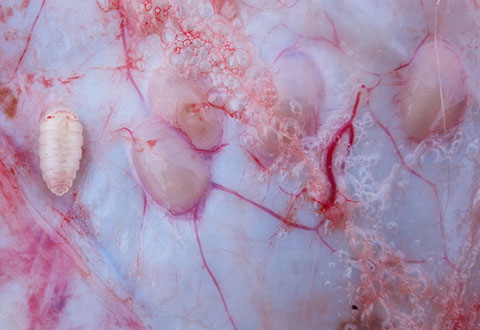Parasites and Diseases
Warbles
A Field Guide
TO COMMON WILDLIFE DISEASES
AND PARASITES IN ALASKA
WARBLES

Underside of caribou hide with several warbles.
| What causes warbles? |
- Warbles are parasitic larvae of the warble fly.
- Lifecycle: The adult fly lays eggs on the hairs of the caribou’s legs and lower body. The eggs hatch into larvae. The larvae penetrate the skin, and travel under the skin to the caribou’s back. The warbles grow there until early summer, when they break through the skin and drop to the ground.
| Where are warbles found? |
- Warbles can be found on caribou throughout their range in Alaska.
| What are the signs of warbles? |
- Caribou usually appear healthy, although animals with heavy infections may be weak.
- While laying their eggs, warble flies harass caribou and interfere with feeding.
- Warble fly larvae are found under the skin on the caribou’s back.
- Larvae are yellowish-white, oval grubs about 1 inch long.
- There is often swelling and fluid in nearby tissue.
- The number of warbles can range from 1 to over 1000 on each animal.
| How can I protect myself? |
- You cannot be infected by warble flies or their larvae.
| Can I eat the meat? |
- Meat from affected animals is suitable for human consumption.
- Warbles in caribou reduce the quality of both hide and carcass.
| Samples to collect |
- Larvae of the warble fly
- To report an occurrence or to submit a sample for identification/analysis, contact the DWC Wildlife Disease Surveillance reporting hotline 907-328-8354, send an email to dfg.dwc.vet@alaska.gov or visit your local ADF&G office.
